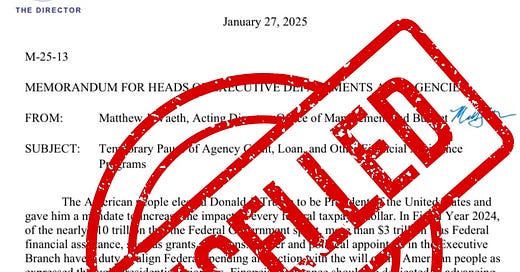The Federal Funding Freeze and Rescission:
The Cycles of Abuse and Why We Must Stop Playing Their Game
They froze it.
We panicked.
They rescinded it.
We exhaled.
Does that sound familiar? It should, because this is how the cycle of abuse works.
In toxic, abusive relationships, the abuser creates chaos and fear—pulling the rug out from under you, destabilizing your sense of safety. Then, when you’re on the verge of breakdown, they “restore order” and offer relief, making you feel grateful they’ve “fixed” what they broke in the first place. It keeps you dependent. It keeps you trapped.
The government, whether intentionally or not, operates on a similar cycle:
Trigger a crisis (the freeze)
Watch the panic spread as people fear for their housing, food, and healthcare
Restore what was taken (the rescission)
Leave people feeling temporarily relieved but ultimately disempowered
This isn’t about solving problems—it’s about controlling the narrative. They create the storm and then act like the hero for “calming” it, when in reality, they’ve reinforced the message that we’re powerless without them. But here’s the truth: We’re not powerless. We’ve just been conditioned to believe we are.
The Power in Recognizing the Pattern
When you see the cycle of abuse for what it is, you stop waiting for relief from the same system causing the harm. Just like in abusive relationships, the answer isn’t to wait for the abuser to change—it’s to build a life outside their control.
This is where community care and self-reliance come in. Because if we keep relying on unstable infrastructure, we’ll stay locked in this loop. The next crisis will come, the next relief will be temporary, and the cycle will continue. But we have the power to disrupt this.
Breaking the Cycle: We Don’t Need Their “Relief”—We Need Each Other
The government’s infrastructure is unreliable by design. Our communities, however, can be as stable as we make them. We can build networks that don’t crumble every time a policy shifts.
Here’s how we break free:
Stop relying on the government for stability. Their role in the cycle of abuse is clear—they aren’t here to save us, and that’s not where we should place our trust. Place it in each other instead.
Create mutual aid networks. We don’t need permission or government programs to take care of each other. We need local solutions where neighbors show up for neighbors—food, housing, childcare, and healthcare through community support.
Get creative about building self-sufficient ecosystems. Think about co-ops, shared childcare, bartering systems, urban farming, and skill exchanges. There’s more freedom in community collaboration than in waiting for the government’s next decision.
Build resilient information networks. Platforms like TikTok, grassroots messaging channels, and community boards allow us to communicate outside the mainstream panic-driven news cycle. When we control the flow of information, we control our responses.
Foster radical imagination. Stop imagining that relief comes from policies “restored” by the same people who threatened to take it away. Imagine a world where we don’t need them in the first place.
A Cycle We’ve Seen Before
This isn’t the first time the government has created chaos to reinforce dependency. Look at history:
During the Great Depression, people begged for basic relief—after banks, landowners, and employers exploited them. The government handed out limited programs like scraps to keep people loyal.
The 2008 financial crisis left millions jobless and homeless because of corporate greed, and after bailing out the banks, the government offered just enough relief to stop an uprising—but not enough to fix systemic issues.
COVID-19 relief was a temporary bandage that left millions still struggling while billionaires got richer. The panic? Manufactured. The relief? Bare minimum.
The funding freeze and rescission follow this same script:
Give just enough pain to make people fear the worst, and just enough relief to keep them from revolting.
We Don’t Need to Be Rescued—We Need to Be Free
Here’s what they don’t want you to realize:
We are closer to liberation when we rely on each other, not them.
We have the power to take care of each other without waiting for the next “rescission.”
We don’t have to stay in this cycle of chaos and relief—we can build something new.
Because the truth is, relief is fleeting, but community is forever. The government will continue to create chaos and present temporary solutions, but we have the power to create sustainable care that doesn’t rely on their approval or infrastructure.
💡 Start small. Start local. But start. Stop paying attention to the White House’s theatrics. The revolution won’t come from there—it will come from us.
What would breaking this cycle look like in your community? Let’s imagine it together. Drop your thoughts below.
As I said in this article: This is how control is maintained—not just through the initial act of disconnection but through the dependency it creates.
Snapping Into Isolation: How We Lost Community at the Tipping Point of Change
I had this one just waiting because I know abuse when I see it. Take a breath, drink some water, and move your body.
Let’s keep this conversation going. We don’t have to play into the cycle of panic and relief—we can build something better, together. Join me tomorrow for Day 10 of our 100 Days of Community as we continue to grow, learn, and explore how to be interdependent upon one another instead of relying on unstable systems.
Because when we lean on each other, we win.
See you tomorrow!
In solidarity and liberation,
Desireé B. Stephens CSP-P
Educator | Counselor | Community Builder
Founder, Make Shi(f)t Happen






Nailed it. Thanks for being our guide in building community! I reached out to some admins in local Facebook groups to see if we might start a local mutual aid network thanks to your inspiration!
Even as I build community I keep this strange hope that government will do the things to invoke change. It is exactly like believing ‘it will be different this time’ with an abusive partner.